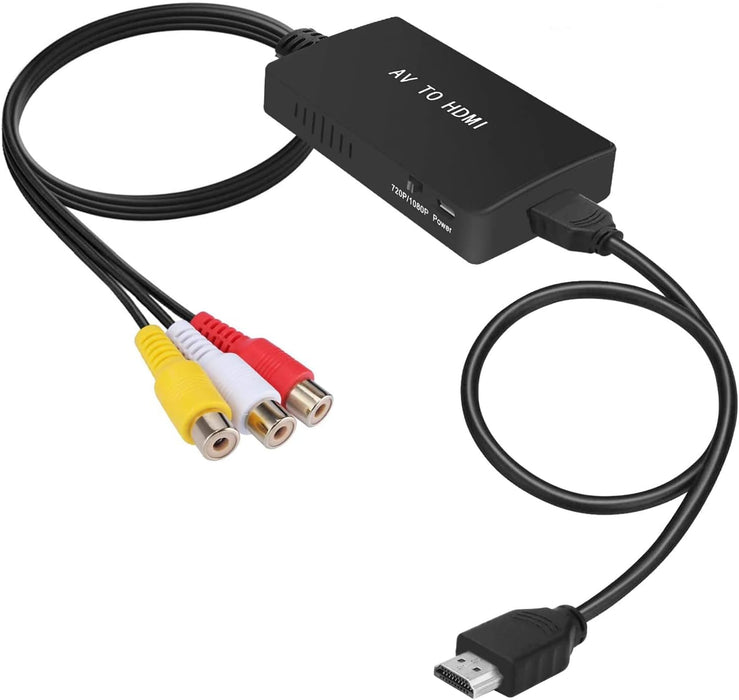
AV (RCA) to HDMI Converter
AV (RCA) to HDMI Converter
An AV (RCA) to HDMI converter is a device used to convert analog composite video and audio signals (typically from RCA connections) into a digital HDMI signal. This allows older devices that use RCA outputs (such as VCRs, DVD players, or game consoles) to be connected to modern digital displays, such as flat-screen HDTVs, projectors, or monitors that only support HDMI input.
Key Features and Specifications:
-
Input:
-
RCA (AV): Typically, RCA connectors consist of three color-coded plugs:
- Yellow for video (composite video signal).
- Red and White for audio (right and left stereo channels).
- These are the standard analog outputs found on older devices like DVD players, camcorders, and game consoles.
-
RCA (AV): Typically, RCA connectors consist of three color-coded plugs:
-
Output:
- HDMI: The converter outputs the signal through a HDMI port, which is compatible with modern TVs, projectors, or monitors. HDMI is a digital signal that carries both high-definition video and multi-channel audio.
-
Video Resolution Support:
- The converter may support different video resolutions, typically including:
- 480p (standard definition) or 576p (PAL standard).
- Some advanced models may support higher resolutions, such as 720p or 1080p (Full HD), but the maximum resolution will still depend on the quality of the original RCA signal.
- The converter may support different video resolutions, typically including:
-
Audio:
- The converter passes stereo audio (left and right channels) from the RCA audio connectors into the HDMI output, supporting 2.0 stereo sound.
-
Plug-and-Play:
- Most AV to HDMI converters are plug-and-play, meaning no drivers or software installation is needed. You simply connect the RCA cables from the source device to the converter, and the HDMI output goes to the display.
-
Power Supply:
- Some converters are USB-powered, using a micro-USB cable to provide power from the TV's USB port or from an external adapter. Others may require an external 5V power adapter for operation.
Applications:
-
Connecting Older Devices to Modern Displays:
- Useful for connecting older gaming consoles (e.g., PlayStation 1, Xbox 360), DVD players, VCRs, or old camcorders to newer HDMI-equipped TVs, projectors, or monitors.
-
Home Theater Systems:
- Can be used to integrate older equipment into a home theater setup, allowing you to connect legacy devices to modern audio-visual equipment.
-
Retro Gaming:
- Great for retro gamers who want to play classic games from older consoles on modern displays without sacrificing video quality.
-
Educational and Professional Use:
- AV to HDMI converters can be used in classrooms or professional settings where older equipment needs to be integrated into modern digital setups, such as presentations or multimedia systems.
How It Works:
-
RCA Input: The converter receives analog signals from the RCA outputs of the source device. This typically includes a composite video signal (yellow) and stereo audio signals (red and white).
-
Digital Conversion: The converter processes the analog signals and converts them into a digital HDMI signal, maintaining synchronization between audio and video.
-
HDMI Output: The converted HDMI signal is sent to the HDMI port of the connected TV or monitor, displaying the video on the screen while transmitting audio through the HDMI connection.
Advantages:
- Compatibility: Allows users to connect older devices with RCA outputs to modern displays with HDMI inputs, extending the life of legacy equipment.
- Cost-Effective: Rather than buying new equipment, the converter provides an affordable solution for upgrading older technology.
- Convenience: Simple plug-and-play setup without the need for specialized software or configuration.
- Wide Application: Can be used for home entertainment, retro gaming, presentations, and more.
Limitations:
- Resolution: Since RCA is an analog signal, the converter may not support high-definition video quality. It may only upscale to a limited resolution like 480p or 720p, depending on the converter's capabilities and the source device's output.
- Sound Quality: Since the audio is being converted to HDMI as stereo sound (2.0), it may not support advanced audio formats such as surround sound (5.1 or 7.1).
